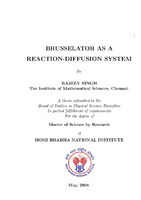- DSpace Home
- →
- IMSc Theses/ Dissertations
- →
- IMSc Theses/ Dissertations
- →
- View Item
JavaScript is disabled for your browser. Some features of this site may not work without it.
| dc.contributor.author | Rajeev Singh | |
| dc.date.accessioned | 2009-09-24T11:35:06Z | |
| dc.date.available | 2009-09-24T11:35:06Z | |
| dc.date.issued | 2009-09-24T11:35:06Z | |
| dc.date.submitted | 2008 | |
| dc.identifier.uri | https://dspace.imsc.res.in/xmlui/handle/123456789/125 | |
| dc.description.abstract | In this work the Brusselator model is studied, which is a minimal mathematical model, for chemical oscillations. The mean field analysis for the model and the traditional way of adding the effect of diffusion is reviewed. The mean field analysis does not capture the stochasticity which is present in any chemical system. The master equation for the brusselator system using the technique of second quantization method and numerical simulation is studied. The effective hamiltonian, and effective action for the brusselator system are derived. It is found that the effective action cannot be used to obtain the differential equation for the field by integration. The numerical simulation is carried out for various parameter values and a transition is found which is different from the transition in the mean-field analysis, for small system sizes observed. The effect of system size is qualitatively studied. Future directions for understanding non-equilibrium chemical phenomena at microscopic level is proposed. | en_US |
| dc.publisher.publisher | ||
| dc.subject | Chemical Oscillations | en_US |
| dc.title | Brusselator as a Reaction-Diffusion system | en_US |
| dc.type.degree | M.Sc | en_US |
| dc.type.institution | HBNI | en_US |
| dc.description.advisor | Rajesh, R. | |
| dc.description.pages | 84p. | en_US |
| dc.type.mainsub | Physics | en_US |
Files in this item
This item appears in the following Collection(s)
-
IMSc Theses/ Dissertations
IMSc Theses/ Dissertations
